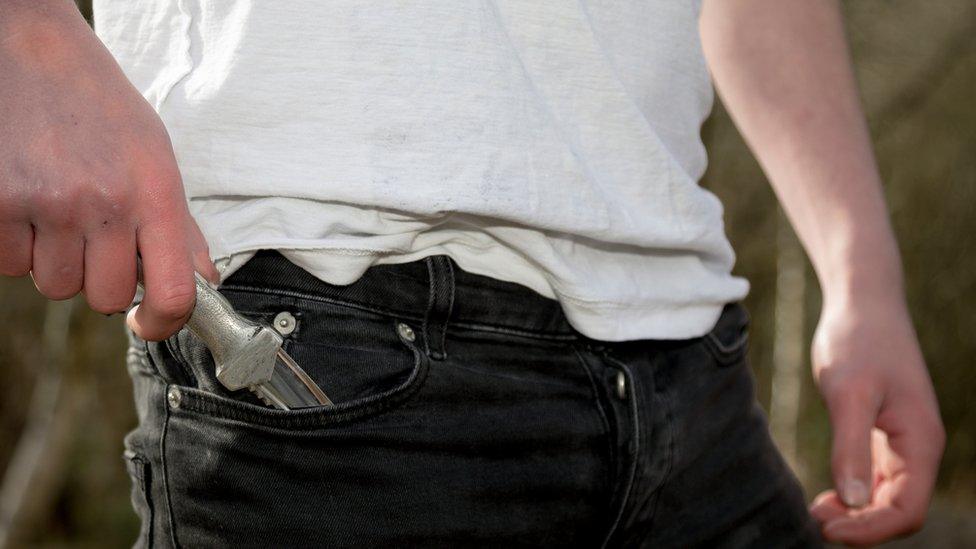Reality Check: Are more teenagers carrying knives?
- Published

Until about 2014, knife crime, as with overall violence, appeared to be on the decline - that's certainly what figures from the police, Ministry of Justice, and health service suggested.
Since then, police forces have been logging more violent offences. Some of that is because of better recording methods - but among the most serious types of violence, there has been a genuine increase.

Worryingly, the involvement of young people in knife crime has been growing, confirming anecdotal evidence that more boys (and girls) are carrying weapons, being drawn into gangs and exploited by drug dealers.

Ten-to-17-year-olds represent roughly 20% of those cautioned or convicted of knife offences - that's possession of a knife or threatening someone with one.
However, the most recent sentencing statistics show a very small decrease.
Most in that age group caught with a knife receive a community sentence or warning. One in nine is sentenced to a spell in youth custody.

The bigger picture
The Office for National Statistics is responsible for the Crime Survey of England and Wales, which estimates crime trends from a sample of 34,000 people aged between 16 and 64.
The advantage of the survey is that it captures incidents that aren't reported to police, as well as those that are.
In a more recent development, the survey has begun interviewing 10-15-year-olds to pick up crime trends among children.
The results indicate that the majority of violent incidents involving children aged 10-15 occur around schools, in daylight - and 92% lead to injury. Around 3% resulted in serious injury.

Police are alerted in only a minority of cases.
Knives and schools
The Millennium Cohort Study asked a representative sample of 14-year-olds whether they carried knives - 3.47% said they did and, of these, 71.3% were boys.
Legislation banning people from carrying knives without good reason dates back 65 years. The maximum sentence is a four-year jail term.
Over the decades the law has been extended and penalties toughened. In 1988 it was made a specific offence to possess a knife in school.
Staff do not need consent to search a pupil for a knife, but guidance recommends, external that there are two teachers present and that children are not asked to remove clothes, except items such as coats.
In 2019, measures were approved by Parliament, external extending the ban on weapons to further education colleges.
The legislation also paves the way for knife-crime "prevention orders" that will allow the courts to apply conditions, such as curfews, exclusion zones and social-media bans on people aged 12 and over suspected of carrying knives.
There's some evidence that more children are taking knives into school.
A Freedom of Information request by BBC News, to which 27 police forces responded, suggested weapon possession at schools had doubled in four years.
Nearly two-thirds were sharp instruments, a category that includes knives but also everything from broken bottles to corkscrews.

The Department for Education has compiled information, external about those who have been caught with a knife.
It showed that 10-18-year-olds convicted of knife-possession offences were generally lower achievers - 91.1% of them achieved one or more GCSEs, compared with 99.7% for the population as a whole - and they were also more likely than their peers to have been excluded from school.
Increasing security
There are clear benefits of having police officers permanently stationed in secondary schools, where they can pick up intelligence, help defuse tensions and win the trust of students. Not every school would want or need one, of course, but some do.
However, there are only 420 safer-school officers in London, a city with 3,155 schools.
The Met Police aims to increase this to 600 by autumn 2019.
The London mayor's office has also encouraged every state-funded secondary school to take up its offer of a knife-detecting "hand wand" - 200 schools have done so.
Across the country, 10 of 33 forces in England recently told a select committee they did not have any dedicated safer-school officers, including West Midlands Police - the largest force outside of London.
Youth Offending
Although there's been a rise in knife crime and strong evidence that young people are increasingly involved, in terms of crime overall there's been a substantial drop over the past decade in the number of 10-17-year-olds being arrested, prosecuted, convicted and detained.
That partly reflects long-term offending trends, as well as efforts by the authorities to avoid criminalising children.

As the numbers of young people in the justice system have fallen, the budget and workforce have been reduced.
Although the cutbacks might make economic sense, they're likely to fuel concerns they've compromised the effectiveness of youth justice services just when they're needed most.
This piece was originally published in November 2018, but is updated regularly to include the latest statistics.

